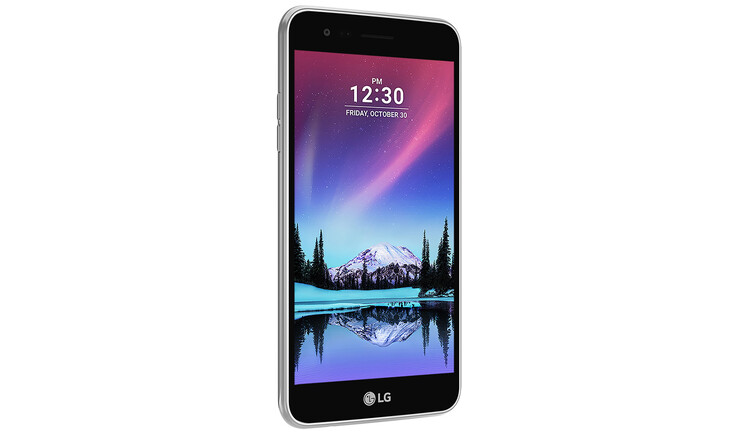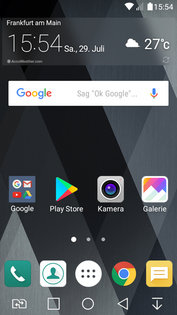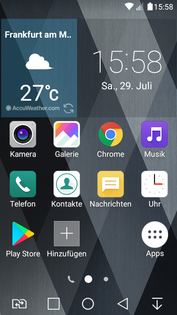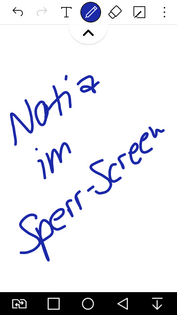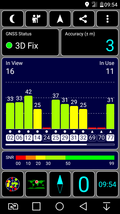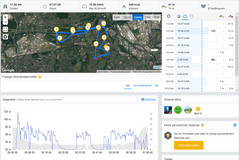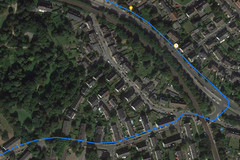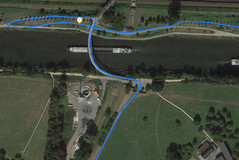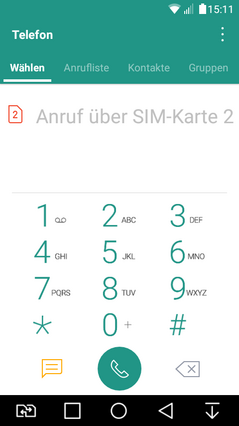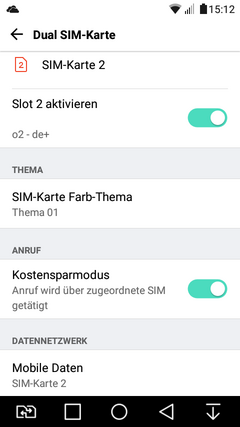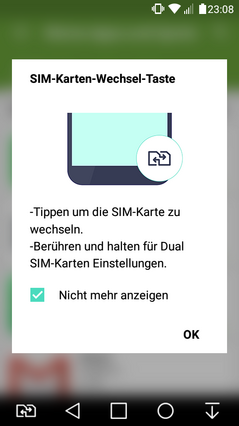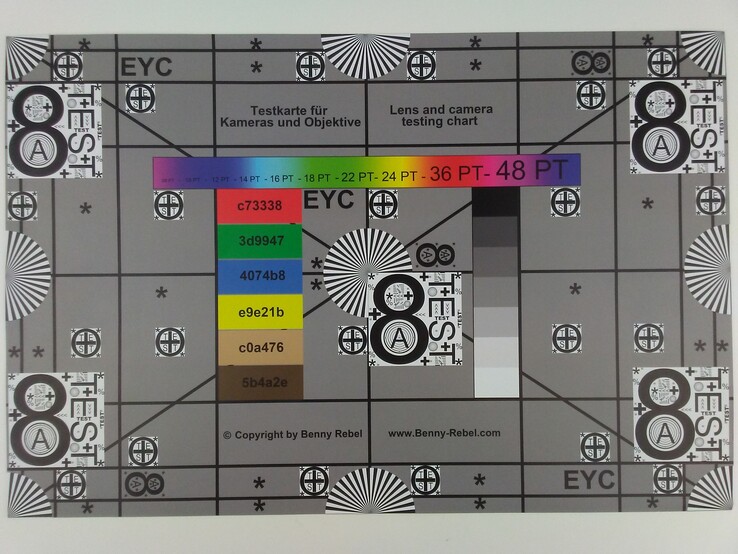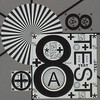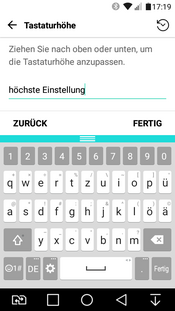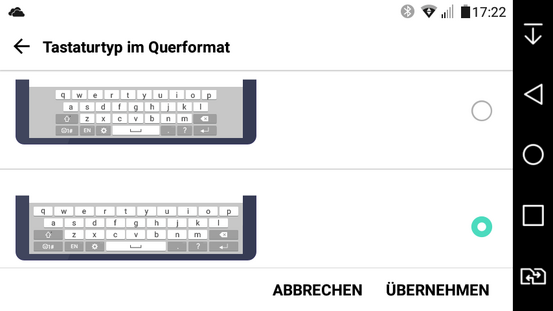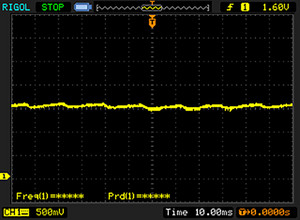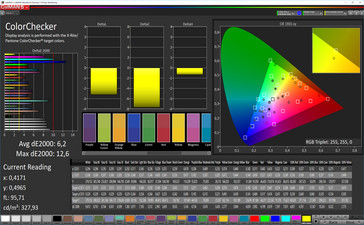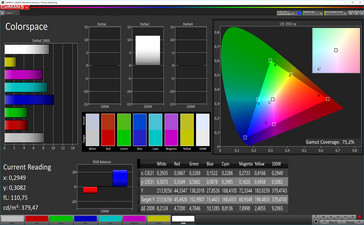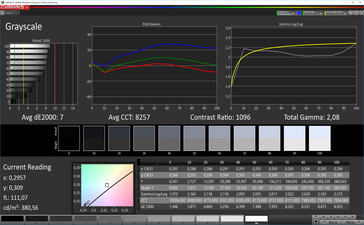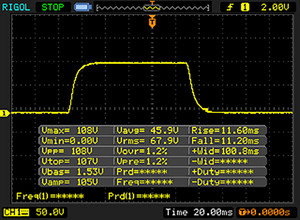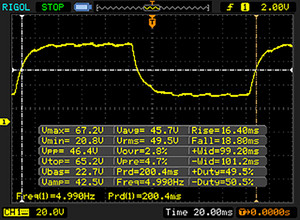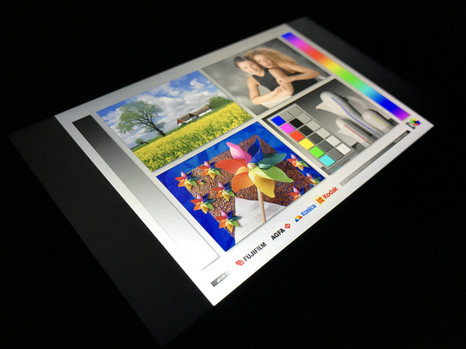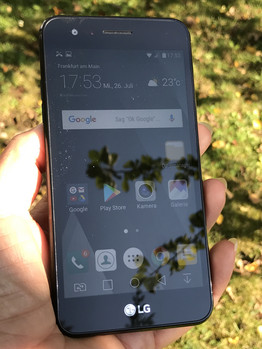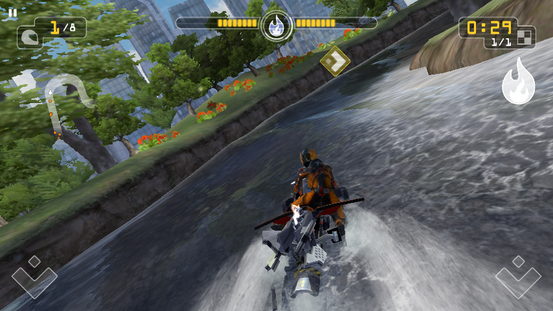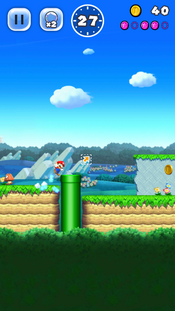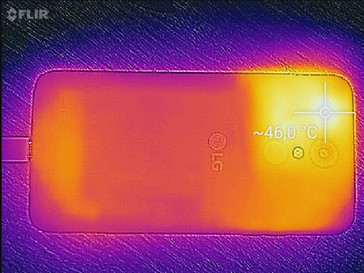LG K4 (2017) Smartphone Review
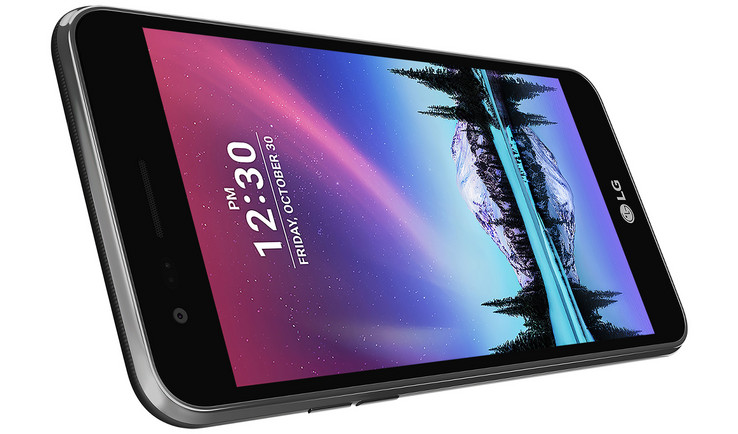
For the original German review, click here.
The LG K4 moves into the second round. The biggest improvement of the 2017 model compared to last year's LG K4 is the LC display, which replaces the old TN panel. Apart from that, not much has changed on the technical side. We have compared the K4 to the Huawei Y5 II, the Sony Xperia E5 and of course the Lenovo K6, which only costs a little more than our device and convinced us with its extensive hardware features during testing.
Case
Optically, the new K4 is a big improvement from the old-fashioned design of its predecessor. Our test unit is black, but there is also a titanium-colored version. The narrow, shiny plastic frame is a nice contrast to the matte black back, which has a nice feel to it thanks to its textured surface. The frame widens a little at the bottom, where the audio and Micro-USB ports are located. This makes the case look even more dynamic.
If you are changing to LG from another smartphone manufacturer, you will look for the on/off button on the side of the device in vain. You will only find the volume rocker; LG has placed the power button on the back of the smartphone. This is where many other LG smartphones have a fingerprint sensor which is used to unlock the device. The K4 is not equipped with a fingerprint sensor, however, but still has the round button at the back. Due to its small size, our finger did not naturally lie on the on/off button and had to be bent to press it. This is not a huge drawback, but can be a little uncomfortable. The display can also be activated by tapping it twice thanks to the LG Knock Code - and then unlocked the usual way.
Connectivity
The LG K4's low storage capacity - users have only 3.6 of the 8 GB available for personal data - is a real drawback: the system started reporting storage problems after installing only a few additional apps and the test unit did not even offer enough storage for us to have all benchmarks apps installed at the same time. On top of that, we received an error message when trying to update pre-existing apps after having installed a few ourselves. So you will probably not manage without an external memory card. The microSD slot is positioned beneath the cover for the exchangeable battery, which should not matter if you use the card as storage expansion. The Micro-USB port does not support USB OTG, so if you want to use a physical device for data transfers, you cannot use a USB stick and will have to use the memory card instead. But at least you do not have to remove the battery to remove the memory card.
The K4 supports Wi-Fi Direct and can be used as a radio with a headset (not included) thanks to the integrated tuner. The device does not have an LED that lets you know whether there are any missed calls or new messages.
Software
The device's operating system is Android 6, which is rather old already; the Android security patches are from the beginning of 2017. It offers three different interfaces, although one of them has to be downloaded if needed. This way, users can decide if they want an app drawer or prefer to have all apps on the home screen. The third option is a simple interface with connections to the contacts and telephone on the main home screen, while other apps and an app drawer can be placed on further home screens. Users can also customize the Android navigation keys.
You will find the Office apps from Polaris and a radio app for the integrated FM tuner among the K4's pre-installed apps. The possibility to take notes via tapping the "louder" side of the volume rocker twice (even from a locked screen) is quite handy.
Communication & GPS
Our test unit does not have NFC, which would speed up making a Bluetooth connection with similarly equipped devices. The Wi-Fi is limited to the 2.4 GHz frequency, which is normal for entry-level devices. The download rate of 54.9 MBit/s is similar to that of our comparison devices. The device supports all frequencies that are relevant in Europe, but lacks bands 12 and 17, which would be important for the US. LTE cat. 4 supports download rates of up to 150 MBit/s and upload rates of up to 50 MBit/s. Even though current smartphones offer higher rates, these results are quite alright for the cheap K4.
| Networking | |
| iperf3 transmit AX12 | |
| Sony Xperia E5 | |
| Lenovo K6 | |
| LG K4 2017 | |
| Gigaset GS160 | |
| iperf3 receive AX12 | |
| Sony Xperia E5 | |
| LG K4 2017 | |
| Lenovo K6 | |
| Gigaset GS160 | |
LG has improved our test unit's GPS module since its predecessor, which can now also receive signals indoors. This is helpful if you want to map a route from home.
The small K4 had a real surprise in store for us when we took it on our usual bike ride with the Garmin Edge 500 (a professional navigation system for bicyclists). The K4 stuck very close to our route and was only a few meters off the measured distance. If the small 5-inch display does not bother you, you can definitely use the K4 as a navigator.
Telephone & Voice Quality
The two SIM cards have their own slots and neither needs to share its space with an optional memory card (this has its own slot in the K4) - which is a configuration that is rather unusual nowadays. Apart from the usual options for deciding which SIM should be used by default for telephoning and data connections, the device also has a dedicated button on the home screen which switches between the two SIM cards. The telephone interface also offers a direct connection and switches to the SMS app with the click of a button.
The voice quality is good in both directions during telephoning and both call partners had no difficulty understanding one another.
Cameras
Both the main and the front camera, which you can switch to by swiping the screen within the camera app, have a maximum of 5 MP and shoot pictures with 3.6 MP in the preset 16:9 format.
The cameras both have good exposure control as you can see from the two pictures below: on the left is a picture we took with the main camera's HDR mode, on the right a selfie at dusk. Both images lack sharpness in the distance, which is a disadvantage, particularly for the main camera.
The device offers HDR, auto focus and an LED flash, but the app does not have any filters or other options - the LG K4 cannot even take a panorama picture.
Unlike the main camera, the selfie camera performs quite well compared to its competition. It does not offer any filters either, but has various possibilities for shutter release: voice commands such as "cheese" "smile" or "LG", gesture commands or the so-called Auto Shot, which uses face recognition technology to automatically take a picture once the image is still. This feature works very well. Another feature of the front camera is that the display can reduce the preview image and turn up the brightness around the image to help in bad lighting conditions.
Color deviation values are quite good as you can see from the photo of the color card. The low-resolution camera cannot produce images with high-resolution details (mono chart).
Accessories & Warranty
The device comes with an 850-mAh power supply and connecting USB cable. LG differentiates between its warranty for the smartphone itself (24 months), parts subject to wear such as the battery, power supply and cable (6 months) and accessories (12 months). Please see our Guarantees, Return policies and Warranties FAQ for country-specific information.
Input Devices & Handling
The capacitive touchscreen can register gestures with up to five fingers. The height of the keyboard can be adjusted and is comfortable to use in portrait mode: Alternative characters are displayed directly on the key and there is another line of numbers above the alphanumeric characters. In the preset for landscape mode, the K4 never uses the full available width, which means that you lose the advantage landscape mode usually brings. This can be changed in the keyboard settings. LG has added another feature which was not available for the old K4: gesture typing.
Display
The K4's LC display still has only 854x480 pixels, which is low, even for a small 5-inch display with a pixel density of only 196 PPI. Brightness distribution is very even at 92% and the average brightness is 372 cd/m². The low black value also means good contrast values of 1:1100.
LG has equipped the model from 2017 with an ambient light sensor that automatically regulates the screen brightness.
| |||||||||||||||||||||||||
Brightness Distribution: 92 %
Center on Battery: 385 cd/m²
Contrast: 1100:1 (Black: 0.35 cd/m²)
ΔE ColorChecker Calman: 6.2 | ∀{0.5-29.43 Ø4.78}
ΔE Greyscale Calman: 7 | ∀{0.09-98 Ø5}
Gamma: 2.08
CCT: 8257 K
| LG K4 2017 854x480, 5" | Huawei Y5 II IPS, 1280x720, 5" | Huawei Y6 II Compact IPS, 1280x720, 5" | Gigaset GS160 IPS, 1280x720, 5" | Sony Xperia E5 IPS, 1280x720, 5" | Lenovo K6 IPS, 1920x1080, 5" | HTC Desire 530 IPS, 1280x720, 5" | |
|---|---|---|---|---|---|---|---|
| Screen | -28% | -16% | -11% | 25% | 13% | 10% | |
| Brightness middle (cd/m²) | 385 | 465 21% | 491 28% | 489 27% | 538 40% | 470 22% | 375 -3% |
| Brightness (cd/m²) | 372 | 443 19% | 487 31% | 479 29% | 534 44% | 461 24% | 376 1% |
| Brightness Distribution (%) | 92 | 90 -2% | 92 0% | 95 3% | 96 4% | 88 -4% | 91 -1% |
| Black Level * (cd/m²) | 0.35 | 0.84 -140% | 0.9 -157% | 0.55 -57% | 0.33 6% | 0.38 -9% | 0.32 9% |
| Contrast (:1) | 1100 | 554 -50% | 546 -50% | 889 -19% | 1630 48% | 1237 12% | 1172 7% |
| Colorchecker dE 2000 * | 6.2 | 7.8 -26% | 6.6 -6% | 8.3 -34% | 5.7 8% | 5.2 16% | 6 3% |
| Colorchecker dE 2000 max. * | 12.6 | 15.7 -25% | 12.9 -2% | 14.4 -14% | 11 13% | 9.5 25% | 9.5 25% |
| Greyscale dE 2000 * | 7 | 8.4 -20% | 4.9 30% | 8.7 -24% | 4.7 33% | 5.6 20% | 4.5 36% |
| Gamma | 2.08 106% | 2.07 106% | 2.12 104% | 2.08 106% | 2.51 88% | 2.24 98% | 2.26 97% |
| CCT | 8257 79% | 8438 77% | 7090 92% | 9034 72% | 7264 89% | 7924 82% | 6975 93% |
* ... smaller is better
Screen Flickering / PWM (Pulse-Width Modulation)
| Screen flickering / PWM not detected | |||
In comparison: 53 % of all tested devices do not use PWM to dim the display. If PWM was detected, an average of 8108 (minimum: 5 - maximum: 343500) Hz was measured. | |||
The new LC display does better than its predecessor's TN panel in our tests. Although the new display has a blue cast and images appear rather cool, the color temperature of 8257 K is closer to the ideal 6000 K than its predecessor was with 9372 K. Color space deviation has dropped from 11.4 to 6.2 (sRGB) and 11 to 7 (gray scales), which is a significant difference.
Display Response Times
| ↔ Response Time Black to White | ||
|---|---|---|
| 15.6 ms ... rise ↗ and fall ↘ combined | ↗ 13.2 ms rise | |
| ↘ 12.4 ms fall | ||
| The screen shows good response rates in our tests, but may be too slow for competitive gamers. In comparison, all tested devices range from 0.1 (minimum) to 240 (maximum) ms. » 36 % of all devices are better. This means that the measured response time is better than the average of all tested devices (20.2 ms). | ||
| ↔ Response Time 50% Grey to 80% Grey | ||
| 46 ms ... rise ↗ and fall ↘ combined | ↗ 22.8 ms rise | |
| ↘ 23.2 ms fall | ||
| The screen shows slow response rates in our tests and will be unsatisfactory for gamers. In comparison, all tested devices range from 0.165 (minimum) to 636 (maximum) ms. » 78 % of all devices are better. This means that the measured response time is worse than the average of all tested devices (31.6 ms). | ||
Thanks to the ambient light sensor, brightness increases automatically to 372 cd/m² outdoors, which makes it possible to read the K4's screen despite some reflections. Viewing-angle stability has been improved by the LC display and it now has only very slight color deviation when looking at the screen from the side.
On last year's model, you could hardly recognize any color when looking from the side; this year the new LC display just gives the colors a light yellow tinge.
Performance
The Qualcomm Snapdragon 210 (MSM8909) is mainly used in entry-level smartphones, including our LG K4. It cannot offer very high performance, particularly combined with only 1 GB of RAM. The combination goes about its work slowly and if you are used to faster smartphones, you might need a little patience when opening apps or switching between open apps.
The K4 remains at the bottom of the list in most of the following benchmarks and some of the graphics tests of the 3DMark and GFXBench programs could not even be carried out. If you like a fast phone, you will not be happy with the LG K4.
| AnTuTu v6 - Total Score (sort by value) | |
| LG K4 2017 | |
| Huawei Y5 II | |
| Huawei Y6 II Compact | |
| Gigaset GS160 | |
| Sony Xperia E5 | |
| Lenovo K6 | |
| HTC Desire 530 | |
| PCMark for Android | |
| Work performance score (sort by value) | |
| LG K4 2017 | |
| Huawei Y5 II | |
| Huawei Y6 II Compact | |
| Gigaset GS160 | |
| Sony Xperia E5 | |
| Lenovo K6 | |
| HTC Desire 530 | |
| Work 2.0 performance score (sort by value) | |
| LG K4 2017 | |
| Sony Xperia E5 | |
| Geekbench 4.4 | |
| 64 Bit Single-Core Score (sort by value) | |
| LG K4 2017 | |
| Sony Xperia E5 | |
| 64 Bit Multi-Core Score (sort by value) | |
| LG K4 2017 | |
| Sony Xperia E5 | |
| GFXBench (DX / GLBenchmark) 2.7 | |
| T-Rex Onscreen (sort by value) | |
| LG K4 2017 | |
| Huawei Y5 II | |
| Huawei Y6 II Compact | |
| Gigaset GS160 | |
| Sony Xperia E5 | |
| Lenovo K6 | |
| HTC Desire 530 | |
| 1920x1080 T-Rex Offscreen (sort by value) | |
| LG K4 2017 | |
| Huawei Y5 II | |
| Huawei Y6 II Compact | |
| Gigaset GS160 | |
| Sony Xperia E5 | |
| Lenovo K6 | |
| HTC Desire 530 | |
| GFXBench 3.0 | |
| on screen Manhattan Onscreen OGL (sort by value) | |
| LG K4 2017 | |
| Huawei Y5 II | |
| Huawei Y6 II Compact | |
| Gigaset GS160 | |
| Sony Xperia E5 | |
| Lenovo K6 | |
| HTC Desire 530 | |
| 1920x1080 1080p Manhattan Offscreen (sort by value) | |
| LG K4 2017 | |
| Huawei Y5 II | |
| Huawei Y6 II Compact | |
| Gigaset GS160 | |
| Sony Xperia E5 | |
| Lenovo K6 | |
| HTC Desire 530 | |
When browsing with the installed Chrome browser, speeds depend on whether the page you are trying to load is optimized for mobile devices. If not, it can take quite a while to load images. Loading times are almost twice as long compared to the Lenovo K6.
| JetStream 1.1 - Total Score | |
| Lenovo K6 | |
| Huawei Y5 II | |
| Huawei Y6 II Compact | |
| Sony Xperia E5 | |
| Gigaset GS160 | |
| HTC Desire 530 | |
| LG K4 2017 | |
| Octane V2 - Total Score | |
| Lenovo K6 | |
| Sony Xperia E5 | |
| Huawei Y6 II Compact | |
| Huawei Y5 II | |
| Gigaset GS160 | |
| HTC Desire 530 | |
| LG K4 2017 | |
| Mozilla Kraken 1.1 - Total | |
| LG K4 2017 | |
| HTC Desire 530 | |
| Gigaset GS160 | |
| Huawei Y6 II Compact | |
| Sony Xperia E5 | |
| Huawei Y5 II | |
| Lenovo K6 | |
* ... smaller is better
According to LG, the maximum capacity of the optional memory card is 32 Gigabytes. When we measured the read/write speeds, the LG K4 reached similar speeds to the Sony Xperia E5 and the Lenovo K6:
| LG K4 2017 | Huawei Y5 II | Huawei Y6 II Compact | Gigaset GS160 | Sony Xperia E5 | Lenovo K6 | HTC Desire 530 | |
|---|---|---|---|---|---|---|---|
| AndroBench 3-5 | -60% | -60% | -58% | -6% | 9% | -56% | |
| Sequential Read 256KB SDCard (MB/s) | 75.3 | 29.47 -61% | 31.57 -58% | 30.71 -59% | 65 -14% | 78.2 4% | 35.56 -53% |
| Sequential Write 256KB SDCard (MB/s) | 44.41 | 18.03 -59% | 17.12 -61% | 19.19 -57% | 45.56 3% | 50.4 13% | 18.22 -59% |
Games
Low processor performance, limited RAM and not a lot of pixels - the K4 with an Adreno 304 GPU does not look like a very promising gamer from the start. You will need patience for the loading times alone. Once the game is running, apps like “Super Mario” can run quite smoothly. “Riptide GP” jerked occasionally, but there were no real problems. The motion sensor reacts too slowly when you are driving out of a bend, so the K4 is not suitable for Racing games.
Emissions
Temperature
We measured an increase in temperature around the top of the smartphone in our measurements and this development also becomes noticeable rather quickly in everyday use. Even after a short telephone call the K4 heats up enough to make it feel uncomfortable on the ear.
(±) The maximum temperature on the upper side is 42.1 °C / 108 F, compared to the average of 35.2 °C / 95 F, ranging from 21.9 to 247 °C for the class Smartphone.
(±) The bottom heats up to a maximum of 43.5 °C / 110 F, compared to the average of 34 °C / 93 F
(+) In idle usage, the average temperature for the upper side is 30.9 °C / 88 F, compared to the device average of 32.9 °C / 91 F.
Speakers
The quality of the integrated mono speaker is OK for a smartphone just over $100. Sure, volume and sound are rather flat, but music sounds good and is not tinny or distorted. You will need a headset to enjoy your favorite music, but it should be enough for a little breakfast radio or listening to music from the local radio station in the evenings.
LG K4 2017 audio analysis
(+) | speakers can play relatively loud (86.5 dB)
Bass 100 - 315 Hz
(-) | nearly no bass - on average 38.2% lower than median
(±) | linearity of bass is average (7.6% delta to prev. frequency)
Mids 400 - 2000 Hz
(±) | reduced mids - on average 7% lower than median
(±) | linearity of mids is average (9.3% delta to prev. frequency)
Highs 2 - 16 kHz
(+) | balanced highs - only 4.5% away from median
(+) | highs are linear (5.2% delta to prev. frequency)
Overall 100 - 16.000 Hz
(±) | linearity of overall sound is average (26.7% difference to median)
Compared to same class
» 68% of all tested devices in this class were better, 6% similar, 26% worse
» The best had a delta of 11%, average was 35%, worst was 134%
Compared to all devices tested
» 81% of all tested devices were better, 4% similar, 15% worse
» The best had a delta of 4%, average was 24%, worst was 134%
Huawei Y5 II audio analysis
(+) | speakers can play relatively loud (87 dB)
Bass 100 - 315 Hz
(-) | nearly no bass - on average 29.4% lower than median
(±) | linearity of bass is average (9% delta to prev. frequency)
Mids 400 - 2000 Hz
(±) | higher mids - on average 7.3% higher than median
(±) | linearity of mids is average (10.1% delta to prev. frequency)
Highs 2 - 16 kHz
(±) | higher highs - on average 13% higher than median
(+) | highs are linear (5.7% delta to prev. frequency)
Overall 100 - 16.000 Hz
(-) | overall sound is not linear (34% difference to median)
Compared to same class
» 84% of all tested devices in this class were better, 1% similar, 15% worse
» The best had a delta of 11%, average was 35%, worst was 134%
Compared to all devices tested
» 92% of all tested devices were better, 1% similar, 6% worse
» The best had a delta of 4%, average was 24%, worst was 134%
Huawei Y6 II Compact audio analysis
(+) | speakers can play relatively loud (86.4 dB)
Bass 100 - 315 Hz
(-) | nearly no bass - on average 31% lower than median
(±) | linearity of bass is average (7.3% delta to prev. frequency)
Mids 400 - 2000 Hz
(±) | reduced mids - on average 7.7% lower than median
(±) | linearity of mids is average (11.7% delta to prev. frequency)
Highs 2 - 16 kHz
(±) | higher highs - on average 13.4% higher than median
(+) | highs are linear (5.9% delta to prev. frequency)
Overall 100 - 16.000 Hz
(-) | overall sound is not linear (35.6% difference to median)
Compared to same class
» 85% of all tested devices in this class were better, 1% similar, 14% worse
» The best had a delta of 11%, average was 35%, worst was 134%
Compared to all devices tested
» 93% of all tested devices were better, 1% similar, 6% worse
» The best had a delta of 4%, average was 24%, worst was 134%
Gigaset GS160 audio analysis
(±) | speaker loudness is average but good (80.7 dB)
Bass 100 - 315 Hz
(-) | nearly no bass - on average 29.2% lower than median
(±) | linearity of bass is average (12.7% delta to prev. frequency)
Mids 400 - 2000 Hz
(±) | higher mids - on average 7.4% higher than median
(±) | linearity of mids is average (8.3% delta to prev. frequency)
Highs 2 - 16 kHz
(+) | balanced highs - only 3% away from median
(+) | highs are linear (5.6% delta to prev. frequency)
Overall 100 - 16.000 Hz
(±) | linearity of overall sound is average (28.1% difference to median)
Compared to same class
» 73% of all tested devices in this class were better, 5% similar, 23% worse
» The best had a delta of 11%, average was 35%, worst was 134%
Compared to all devices tested
» 85% of all tested devices were better, 3% similar, 12% worse
» The best had a delta of 4%, average was 24%, worst was 134%
Sony Xperia E5 audio analysis
(±) | speaker loudness is average but good (76.5 dB)
Bass 100 - 315 Hz
(-) | nearly no bass - on average 21.6% lower than median
(±) | linearity of bass is average (8.1% delta to prev. frequency)
Mids 400 - 2000 Hz
(±) | higher mids - on average 5.5% higher than median
(±) | linearity of mids is average (9.6% delta to prev. frequency)
Highs 2 - 16 kHz
(±) | higher highs - on average 6.5% higher than median
(±) | linearity of highs is average (9.5% delta to prev. frequency)
Overall 100 - 16.000 Hz
(-) | overall sound is not linear (30.1% difference to median)
Compared to same class
» 78% of all tested devices in this class were better, 3% similar, 18% worse
» The best had a delta of 11%, average was 35%, worst was 134%
Compared to all devices tested
» 88% of all tested devices were better, 3% similar, 9% worse
» The best had a delta of 4%, average was 24%, worst was 134%
Lenovo K6 audio analysis
(+) | speakers can play relatively loud (83.6 dB)
Bass 100 - 315 Hz
(-) | nearly no bass - on average 25.8% lower than median
(±) | linearity of bass is average (9.1% delta to prev. frequency)
Mids 400 - 2000 Hz
(±) | reduced mids - on average 9.3% lower than median
(+) | mids are linear (6.9% delta to prev. frequency)
Highs 2 - 16 kHz
(+) | balanced highs - only 3.9% away from median
(+) | highs are linear (4.9% delta to prev. frequency)
Overall 100 - 16.000 Hz
(±) | linearity of overall sound is average (23.5% difference to median)
Compared to same class
» 53% of all tested devices in this class were better, 8% similar, 39% worse
» The best had a delta of 11%, average was 35%, worst was 134%
Compared to all devices tested
» 69% of all tested devices were better, 6% similar, 24% worse
» The best had a delta of 4%, average was 24%, worst was 134%
HTC Desire 530 audio analysis
(+) | speakers can play relatively loud (87.4 dB)
Bass 100 - 315 Hz
(-) | nearly no bass - on average 41% lower than median
(+) | bass is linear (4.1% delta to prev. frequency)
Mids 400 - 2000 Hz
(±) | reduced mids - on average 7.8% lower than median
(±) | linearity of mids is average (10.8% delta to prev. frequency)
Highs 2 - 16 kHz
(±) | higher highs - on average 7.4% higher than median
(+) | highs are linear (5.7% delta to prev. frequency)
Overall 100 - 16.000 Hz
(-) | overall sound is not linear (31.2% difference to median)
Compared to same class
» 80% of all tested devices in this class were better, 3% similar, 17% worse
» The best had a delta of 11%, average was 35%, worst was 134%
Compared to all devices tested
» 90% of all tested devices were better, 2% similar, 8% worse
» The best had a delta of 4%, average was 24%, worst was 134%
Frequency diagram in comparison (checkboxes can be turned on/off!)
Battery Runtimes
Power Consumption
LG has managed to keep the K4's power consumption low and the device does better than all comparison devices in this respect. The provided power supply is below the usual standard of 1000 mAh and offers only 850 mAh, which is rather unusual. With this power supply, the K4 needs about three hours for the 2500-mAh battery to fully recharge.
| Off / Standby | |
| Idle | |
| Load |
|
Key:
min: | |
| LG K4 2017 2500 mAh | Huawei Y5 II 2200 mAh | Huawei Y6 II Compact 2200 mAh | Gigaset GS160 2500 mAh | Sony Xperia E5 2300 mAh | Lenovo K6 3000 mAh | HTC Desire 530 2200 mAh | |
|---|---|---|---|---|---|---|---|
| Power Consumption | -40% | -43% | -55% | -90% | -55% | -132% | |
| Idle Minimum * (Watt) | 0.64 | 0.54 16% | 0.57 11% | 0.56 12% | 1.03 -61% | 0.65 -2% | 1.58 -147% |
| Idle Average * (Watt) | 1.14 | 1.58 -39% | 1.53 -34% | 1.7 -49% | 2.06 -81% | 1.65 -45% | 2.59 -127% |
| Idle Maximum * (Watt) | 1.25 | 1.7 -36% | 1.6 -28% | 1.75 -40% | 2.12 -70% | 1.67 -34% | 2.66 -113% |
| Load Average * (Watt) | 2.26 | 2.98 -32% | 2.82 -25% | 4.17 -85% | 5.01 -122% | 3.58 -58% | 5.22 -131% |
| Load Maximum * (Watt) | 2.36 | 4.98 -111% | 5.69 -141% | 5.07 -115% | 5.04 -114% | 5.58 -136% | 5.67 -140% |
* ... smaller is better
Battery Runtime
In our standardized Wi-Fi test the K4 manages a runtime of over ten hours, which is a good value compared to its seven competitors in this review. It can easily beat two of the other devices and the Lenovo K6's twelve hours of battery runtime is probably simply due to its larger battery, so its power consumption rates are not necessarily better than those of the K4.
| LG K4 2017 2500 mAh | Huawei Y5 II 2200 mAh | Huawei Y6 II Compact 2200 mAh | Gigaset GS160 2500 mAh | Sony Xperia E5 2300 mAh | Lenovo K6 3000 mAh | HTC Desire 530 2200 mAh | |
|---|---|---|---|---|---|---|---|
| Battery runtime | -17% | 3% | 2% | -31% | 18% | -30% | |
| WiFi v1.3 (h) | 10.1 | 8.4 -17% | 10.4 3% | 10.3 2% | 7 -31% | 11.9 18% | 7.1 -30% |
| Reader / Idle (h) | 18.4 | 19.6 | 22.1 | 27.1 | 18.6 | ||
| Load (h) | 4.2 | 3.7 | 4.1 | 5.8 | 4.2 | ||
| H.264 (h) | 11.4 | 11.7 | 10.6 | 7.6 |
Pros
Cons
Verdict
Compared to its predecessor, the LG K4 has come into bloom: It has a modern look and a better LC display than the last model had, although its low resolution still is not up to par. Its weak performance - both in the benchmarks and in practice, which becomes apparent through its slow response to inputs, means that we would not recommend the LG K4 to advanced users. If you are looking for a simple, easy-to-use phone, the LG K4 might be worth considering. The options for the home screen and especially the simple switching between the two SIM cards (if needed) are a plus, but there is no getting around the low internal storage. Nobody should have to rely on an external memory card.
LG K4 2017
- 07/31/2017 v6 (old)
Inge Schwabe




